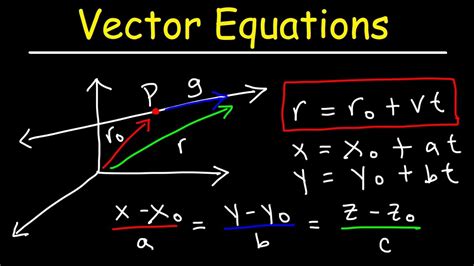Introduction
In the realm of mathematics, parametric equations and vectors play a pivotal role in describing the dynamic nature of geometric objects. They provide a powerful tool for characterizing curves, surfaces, and motion, enabling us to understand the intricate relationships between time and space. In this article, we delve into the fascinating world of parametric equations and vectors, exploring their fundamental concepts, applications, and significance.

Parametric Equations
Definition:
Parametric equations are a set of equations that express the coordinates of a point on a curve as functions of a parameter, typically denoted by the letter “t.” By varying the value of “t,” we can trace out the path of the curve.
Form:
x = f(t)
y = g(t),
where f(t) and g(t) are continuous functions.
Applications:
Parametric equations find widespread use in various fields, including:
– Describing complex curves like ellipses, parabolas, and cubic curves.
– Animating objects in computer graphics and video games.
– Modeling trajectories in physics and engineering.
Vectors
Definition:
A vector is a mathematical object that represents a quantity with both magnitude and direction. It can be visualized as an arrow emanating from a specific point.
Notation:
Vectors are typically denoted by boldface letters (e.g., a, v). Their components are given by their coordinates (e.g., a = [a₁, a₂]).
Magnitude:
The magnitude of a vector v is denoted by |v| and is calculated as the square root of the sum of its components squared:
|**v**| = √(a₁² + a₂²)
Direction:
The direction of a vector is specified by its unit vector, which is obtained by dividing the vector by its magnitude:
**u** = **v** / |**v**|
Applications:
Vectors are ubiquitous in physics, engineering, and computer science, where they are used to represent:
– Forces, displacements, and velocities.
– Geometric quantities like position, orientation, and length.
– Data points and features in machine learning and data science.
Relationship between Parametric Equations and Vectors
Vector Representation of Parametric Curves:
A parametric curve can be represented by a vector function r(t) = [f(t), g(t)]. This function associates a vector with each value of “t,” creating a path in space.
Velocity and Tangent Vector:
The velocity of a point moving along a parametric curve is given by the derivative of the position vector r(t) with respect to “t.” The tangent vector to the curve at a given point is parallel to the velocity vector.
**v(t)** = d**r(t)** / dt
Acceleration and Normal Vector:
The acceleration of a point moving along a parametric curve is given by the second derivative of the position vector r(t) with respect to “t.” The normal vector to the curve at a given point is perpendicular to both the tangent and acceleration vectors.
**a(t)** = d²**r(t)** / dt²
Applications of Parametric Equations and Vectors
The combination of parametric equations and vectors opens up a wide array of applications in various domains:
Computer Graphics
- 3D modeling and animation
- Realistic simulations of motion and deformation
Physics
- Describing trajectories of objects in motion
- Analyzing forces and torques in mechanical systems
Engineering
- Robotics and autonomous systems
- Design and analysis of structures and machines
Data Science
- Data visualization and dimensionality reduction
- Feature extraction and clustering
Other
- Music composition
- Mathematical modeling in finance and economics
How Parametric Equations and Vectors Matter
Unifying Motion and Geometry:
Parametric equations and vectors allow us to bridge the gap between the concepts of motion and geometry. By representing motion as a trajectory of points in space, we can use geometric principles to analyze and predict the behavior of moving objects.
Enhancing Scientific Understanding:
In physics and engineering, parametric equations and vectors provide a powerful tool to describe complex motions and forces, leading to advancements in fields such as celestial mechanics, fluid dynamics, and material science.
Facilitating Data Analysis:
Vectors are crucial in data science for representing and processing multidimensional data. Parametric equations can be used to model complex relationships between variables, aiding in data exploration and prediction.
Common Mistakes to Avoid
-
Mixing up parameters and variables: Ensure that you clearly distinguish between the parameter “t” (which varies) and the variables “x” and “y” (which are functions of “t”).
-
Neglecting units: Remember to include units when dealing with vectors, as they represent both magnitude and direction.
-
Not normalizing vectors: Unit vectors should always have a magnitude of 1, so make sure to normalize vectors when necessary.
-
Ignoring the time component: When working with parametric equations, remember that the parameter “t” represents time and affects the position and motion of the object.
Conclusion
Parametric equations and vectors are fundamental concepts in mathematics that provide a powerful tool for describing and analyzing motion and geometry. Their applications span a wide range of fields, from computer graphics to physics to data science. By understanding the relationship between these two concepts, we can deepen our comprehension of the dynamic world around us and unlock new possibilities for innovation.
